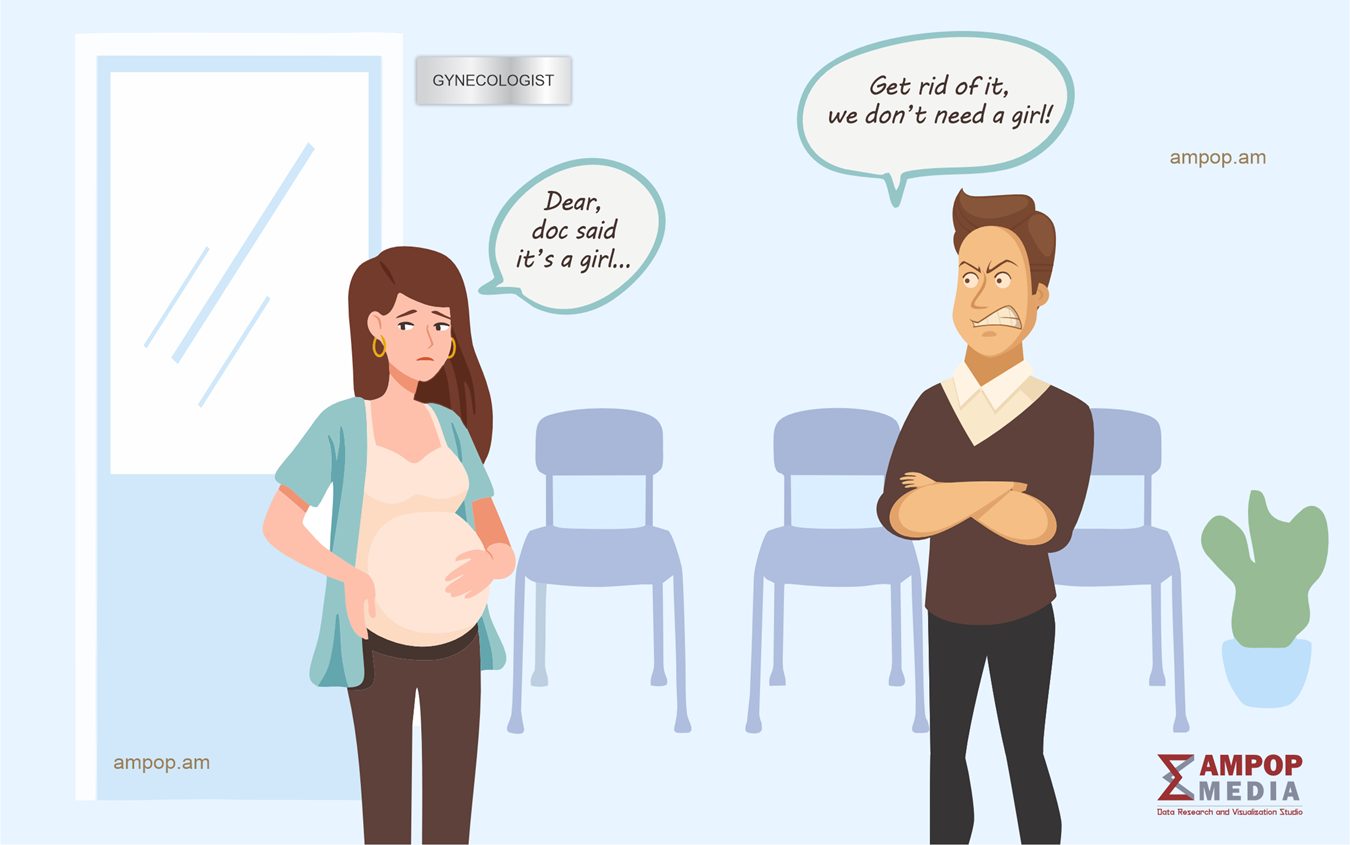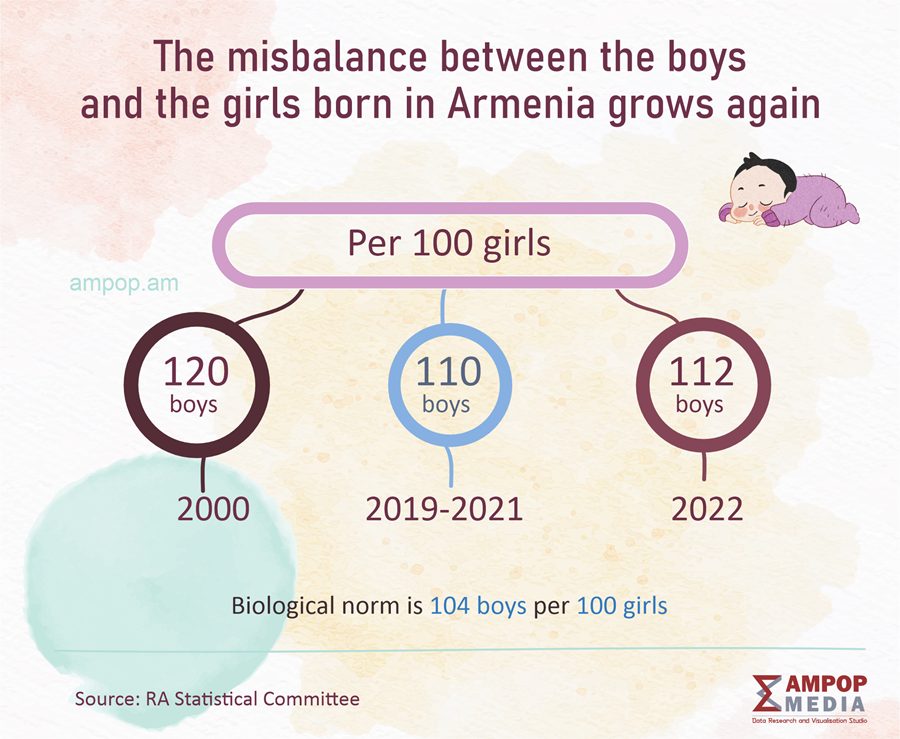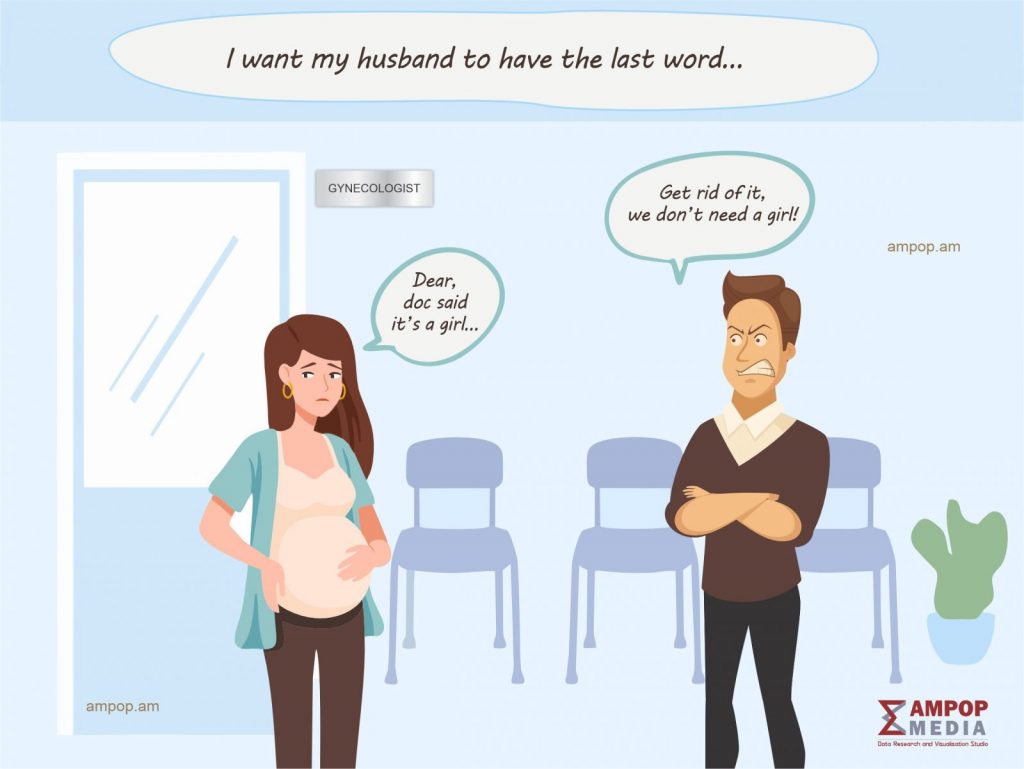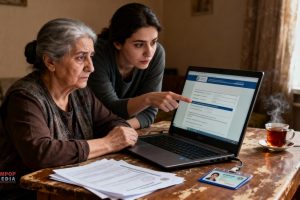Editor’s note: comprised of two parts, this publication is prepared in the memory of those boys and girls, whose lives have been interrupted by a decision of mature people. Here we combine seemingly unrelated issues: the problem of selective abortions and the one of increased demand for surrogacy, specifically, among the parents of the soldiers who fall in the recent wars.
This is an attempt to showcase the situation unfolding in our society, in which the natural course of things or, as the experts call it, the biological norm, is distorted. To embrace the topic, reporter Lilit Harutyunyan used statistical data and contacted dozens of sources, including surrogate mothers, women facing the problem of infertility, women who have opted for a selective abortion, as well as mothers of fallen soldiers, willing to become mothers again, which does not always prove possible due to natural reasons. Armenia is a country with a 15% infertility rate among its population. The World Health Organization says the figures shall raise concerns.
The first part of the story is available here.
A boy or a girl?
We met Gohar, a 31-year-old woman from Gegharkunik, in one of the maternity hospitals in Yerevan. She drove hundreds of kilometers early in the morning to have an ultrasound screening in the hospital we met her. Gohar was among the many women in the long line, committed to get the screening by all means, because there was just one thing that bothered her that day.
“We drove this far just to know if the baby is a boy or a girl. I have had screenings in two other hospitals, both of which confirmed it’s a boy, but they say this hospital gives the most accurate results.”
Gohar is a mother to two girls aged 10 and 8. She now wants to be sure the coming soon baby will be a boy. In case the baby is a girl, the family has decided to interrupt the pregnancy. She says they desperately want a boy, but can’t afford too many kids due to financial reasons.
“My husband works at construction sites, I am unemployed, and we hardly make the two ends meet. We would not have the third baby if we had a boy.”
When is the interruption of pregnancy medically prescribed?
Telling the sex of the baby is impossible at 12 weeks of pregnancy, when its genitals are still shaping.
The educational manual published on the website of the Armenian National Institute of Health indicates that an ultrasound screening is able to provide accurate information on the sex of the fetus only at 14 or 15 weeks of pregnancy when the genitals become clearly identifiable.
And it should be kept in mind that even then the position of the fetus may force the parents wait before it becomes clearly visible if the baby is a girl or a boy.
Armenian legislation stipulates interruption of pregnancy upon woman’s decision to do so is only possible before the 12 weeks. In later stages, selective abortion is allowed only upon a medical prescription or due to social reasons based on a decision of a special commission and no later than the 22 weeks of the pregnancy.
Professionals express concerns over the perspective of illegal abortions by simply registering the interruption at 12 weeks or by forging a medical prescription, or, alternatively, avoiding any registration of abortion whatsoever.
M.D. Karine Saribekyan, advisor to the head of Armenia’s National Institute of Health, says in all the mentioned cases the selective abortion is illegal and is a crime.
Situation
The distribution of sexes among the babies born in the country is a commonly used index for researchers to control the dynamics of sex-selective births.
According to biological norms, the balance between the number of born girls and boys is about 100 to 104-106. That means that boys are born more often than girls because, the experts explain, the mortality rates among boys are higher, female life expectancy is higher, and the nature seems to be compensating the gap; whereas the human factor distorts this balance.
The problem of misbalance among the boys and the girls born in Armenia has emerged, starting from the early 1990s. It has further deepened with the development of the medical technologies of ultrasound screening.
Professionals says women have more than one way to identify the baby’s sex at early stages of pregnancy, including blood tests. At the same time, people seem disinclined to have more babies.
Studies show the reason for the desire to have sons shall be sought for in the paternalistic structure of the society, the dominating role of men, inequality in the status and the opportunities available to men and women.
What happens when a misbalance between the number of boys and girls happens and the number of boys per 100 girls reaches 114 to 120? To start with, Armenia is among the global leaders with the index of such misbalance.
The year 2000 has been the worst in terms of the recorded misbalance level, where the number of boys reached 120 or even 124, in some of the regions against 100 girls.
The indexes started to improve following social campaigns, as well as respective legislative amendments. Statistical data come to support the information: positive dynamics have been registered in the span of three consecutive years from 2019 to 2021: 110 boys were born against 100 girls, although the misbalance remains.
However, a degradation of situation was registered starting from 2022, when 112 boys were born against 100 girls in the same period.
Situation is degrading starting from 2022
In 2022, the United Nations Population Fund and the OxyGen Foundation conducted a research to identify the shifts that have followed the pandemic and the war in 2020.
The study showed that the COVID and various crises have once again revived stereotypes and stereotypical behavioral patterns, which have resulted in increase of the numbers of selective abortions.
Lusine Sargsyan, Gender Programme Coordinator at the UN, says respondents of the conducted surveys point people are concerned with problems of security and opt for having boys.
The UN representative says that, as a rule, stereotypes get deeper in times of crises.
“Worried by the situation with the country’s security, people see having boys as a way to better solve those issues, and that is clearly traceable by the results of the study.”
Sargsyan says there are three main factors triggering sex-selective abortions: technological progress and the attempts to identify the sex of the fetus at early stages of pregnancy; discrimination against women, as well as the social-economic issues, which force people to give preference to having boys.
“There are false, stereotypical perceptions about girls, which believe girls may prove having limited abilities in adulthood, be unable to support parents, or unable to take part in the family matters of parents. All these perceptions make people prefer boys over girls. The reasons behind the problem are the gender stereotypes, as well as the lack of equality of rights among men and women,” Lusine Sargsyan points.
The UN representative also underlines the many values among Armenians which are very much ahead of time; those include the traditional respect for women, the history of rights to inherit property and vote given to women in Armenia among the first countries in the world, are things that need popularization.
Where are the boys, though?
Despite the misbalance in favor of boys in Armenia when planning pregnancies, the statistical data show a different situation.
Although boys dominate in the age group between 0 and 24, their number decreases starting from the age of 25.
Male population makes some 52% in the age group between 20 and 24, whereas females of the same age make 48%; yet, in the next age group including those from 25 to 29 the proportion is 49% against 51%. The number of women increases in higher age groups: e.g. in the age group between 45 and 49, women make 54%, while men are only 46%.
Tigran Jrbashyan, the head of Management Advisory Services at Ameria Advisory, says the male population decreases mostly due to wars and emigration.
The male population decreases mostly due to wars and emigration

Tigran Jrbashyan
According to Jrbashyan, by opting for boys, people create potential threat from a demographic perspective: the problem of lonely mothers increases over years and in a 50 to 100 perspective, the consequences of selective abortions in the country will be immense.
“We face the problems of selective abortions and lonely mothers, which will bring about a dramatic decrease in the number of births, because the perspectives of having baby as a lonely mother are much lower than in full families.”
He says selective abortions result in increased rates of aggression among school-aged boys, since their numbers at schools are above the norms.
Sex-selective abortions result in increased rates of aggression among school-aged boys, since their numbers at schools are above the norms.

Armine Sayadyan, gynecologist and reproductologist at the Research Center of Maternal and Child Health Protection told Ampop Media that families often turn to her for family-planning advice, or for the purpose of sex-based interruption of pregnancy.
“Oftentimes larger families have a decisive role in making the decision which is much more important than a woman’s: that is an extremely painful fact. Too often, women say they want to do as their husbands want. In-laws and women’s own parents play an immense role in addition to the social opinion, which holds that having boys is better than girls. Women coming to me saying they don’t want a girl are very few.”
Sayadyan says she has never agreed on doing selective abortions, and has refused requests for abortions altogether.
“My lovely daughter, you are my conscience”
Doctor Sayadyan is a mother of three boys and tries to serve as role model and to convince women to stay back from interrupting pregnancy. She says she sometimes succeeds in that: “The family had two daughters and was expecting the third one. They had come to me for an abortion. I had the impression it was not a common decision. The woman said she would never expect her husband suggest that they do an abortion, because he had been a good father for their two daughters. We had long conversations with the couple… And I managed to convince them.”
The baby was born in October 2023 bringing happiness to the family.
The mother of the girls agreed to share with Ampop Media on a condition of anonymity. She says her pregnancy was not planned, due to health issues. “When we learned about the pregnancy, my husband said: if we are taking the risk, at least we better have a boy. Everybody does it so we could do that, too. I feel like we were guided by an evil power, but the doctor convinced us to step back. Now, my husband cuddles with our daughter, saying to her: my lovely daughter, you are my conscience.”

Analyzing her professional experience, gynecologist and reproductologist Lilit Karapetyan concludes that most of the time women go for selective abortions succumbing to the families’ pressure, and also the social stereotypes. The number of those who seek abortion at hospitals has not increased over years.
“We do our best to explain the potential problems that may follow… We share about the perspectives of infertility.”
Armenia, Georgia and Azerbaijan are among the countries with significant misbalance between girls and boys. Armenia comes the second in the list, followed by Azerbaijan in the third place; Georgia is on the 12th place.
The vanished girls of Georgia
Journalist Eka Kevanishvili has studied the issue of selective abortions in Georgia as part of partnership project with Ampop Media. She says finding a woman who would agree to speak about the reasons she had opted for selective abortion wasn’t an easy task. None of the participants in women’s forums would respond to her request [Eka’s story in Georgian is available here].
Eka has run a conclusion the topic in Georgia is a taboo, even more than that of menopause which she covered for the Georgian service of the Radio Liberty/Europe.
After several failed attempts to find a woman on social networks, the journalist decided to talk to about ten women of various professions, social groups and ages in Samtskhe-Javakheti, Ratcha, Ajaria and Kakheti. All of her respondents had pointed they had not heard of any such story in recent times, assuming those might have happened before.
After long searches, a woman named Nora agreed to share with Eka the story that happened to her about ten years ago. Nora had given birth to her third child, who appeared to be a girl, all alone. She said were it not for her decision and her brother’s support, her third daughter would have never been born, because everyone in the family wanted “the much-anticipated son”.
Everyone in the family wanted “the much-anticipated son”
“My father-in-law was the first to tell me it was time to have a baby boy. I laughed and rather took it as a joke, but my husband’s moods changed dramatically when we went for an ultrasound screening and were told it was a girl. He kept silent all the way back home,” Nora recalls. She was then 35.
The visit to the doctor was followed by a wider family discussion at dinner.
“They would talk about that yet unborn child as if it was just a thing, like a damaged item at the store which you prefer to have replaced. The next day my husband said they did not want another girl, because they did not want people laugh at him. I remember we had a long discussion, because no one could force me to see a doctor. I refused to obey and soon our relationships deteriorated.”
Nora kept the baby, but left the family. She says she was lucky to have her brother’s support. Were it not for him, she thinks, she might share the fate of other women.
“And then I would think what would be next, would the next child be a boy if I did that [the abortion ], would I be able to love that boy?!”
Nora’s husband remarried two years following their separation and had a baby boy.
“Selectivity here is one of the worst manifestations of discrimination, because that means you decide to have a baby based on its sex,” says Marika Kurdadze of the Georgian Office for the UN Population Fund.
That means you decide to have a baby based on its sex
The UN Population Fund says starting from the end of the 1990s up until mid-2004, about 31,000 baby girls have not been born in Georgia due to selective abortions. Starting from 2004, the index dropped and reached an equilibrium in 2016.
Even today, though, there are regions in Georgia where the balance is in the favor of baby boys. Kakheti, Samtskhe-Javakheti, Kvemo-Kartli are among those regions.
Marika Kurdaze explains although those regions are populated by ethnic minorities, the problem is not culture-specific. The reason, she says, is rather in language barriers, which hinder information from reaching the local population, as well as in the social norms that are hard to modify.
And people have the right to learn a baby’s sex: doctors in Georgia are recommended against revealing it up until the 16 weeks of the pregnancy; this is because artificial interruptions of pregnancy starting from the 16th week are prohibited by law in the country.
Afterword
As for Armenia, parents who use extracorporeal methods of fertilization are allowed to choose the sex of the child. This is possible by making a genetic study in pre-implantation stage. It is mostly done by a medical prescription, and is permitted for families which have three children of the same gender.
Gynecologist and reproductologist Armine Sayadyan says the number of families willing to have a boy to immortalize the names of their fallen sons has increased.
Rosa Mikayelyan, mother of the soldier Davit Torosyan killed during the 44-day war, gave birth to twin boys in September 2023. She had requested doctor Sayadyan, who was performing the extracorporeal fertilization, to check the sex of the embryo.
She was dreaming of having a boy. “I wanted to name the baby after Davit. But then I thought I should rather rely on Lord. Now that the boys are born, I think it would be nice if one of them was a girl for then my daughter would have a sister.”
 The family of soldier Davit, with the newborn twins in the first photograph, and with doctor Sayadyan in the second photograph.
The family of soldier Davit, with the newborn twins in the first photograph, and with doctor Sayadyan in the second photograph.
Read the first part of the story here.
By Lilit Harutyunyan
Illustrations and infographics by Anush Baghdasaryan
Photo credits from the personal archives of sources
Project by Suren Deheryan
The following publications were produced as part of the project Online journalism, in-depth, which is funded by the German Federal Ministry for Economic Cooperation and Development (BMZ). The views expressed in these publications are those of the independent authors and do not necessarily reflect those of the BMZ.
© All the stories, infographics and other visuals bearing the Ampop Media logo is possible to publish on other audiovisual platforms only in case of an agreement reached with Ampop Media and/or JFF.
Փորձագետի կարծիք
First Published: 30/01/2024












